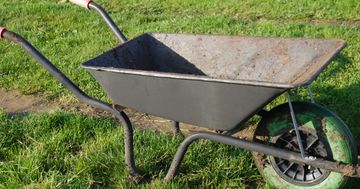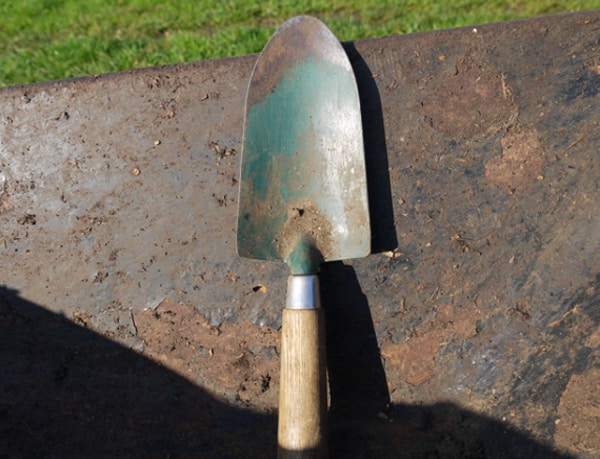Allotment Tools & Equipment


Introduction
Many novice allotment growers have an aspiration, or dream, to return a profit from their vegetable patch. The line of thought is something like this: seeds are very cheap, perhaps £2 a packet, and from this it should be possible to grow a year’s supply of any particular crop.
Step By Step Video
YouTube Video
And then there is reality!
Featured below are what I consider to be the essential tools required to start growing. My quick calculation is that this is an investment in the region of £200-£500, depending upon what a gardener already has and their ambition – and this does not include the gardener's time or the cost for plants and seeds.
Over the years, the initial investment will be repaid and more. Tools should last for many years, and an experienced gardener will learn to grow more with less, what grows best on their plot, ways of extending the harvest season, and how to store crops over the winter months.
Water Pump (or other water supply)

Access to water, and how easy it is to water crops during the height of summer, is one of the most important considerations when planning an allotment. If available, choose a plot near a tap or water pump. This will save considerable time and energy.
Watering Can(s)

Bigger is not always better, but my suggestion is that a gardener buys the biggest watering cans they can comfortably carry. This will reduce the amount of trips needed between the water supply and the crops to be watered. Two watering cans are better than one, as it is a more equal load on a gardener’s shoulders and back.
Spade

An indispensable allotment tool. Over the years, this is the tool I use the most at the allotment, for example to turn the soil over when preparing new growing beds, or to suppress weed growth at the end of summer. A spade can also be used to dig planting holes, trenches for potatoes, or to lift weeds with long roots. Mattocks or digging hoes are an alternative to using a spade.
Fork

Forks are indispensable for breaking up the soil, and for levelling soil that has been freshly dug. It is sometimes easier to dig with a fork than a spade, as the sharp points of a fork more easily penetrate hard ground.
Rake

This is probably the tool I use least compared to others shown on this page. Its role is important nonetheless.
I reach for my rake at seed planting time. The first step is to dig over the bed to loosen the soil, and the second step is to rake the soil to create a fine level surface. This will make it easier for seedlings to burst through after germination. Rakes are also useful for collecting weeds and other debris that may fall onto a plot.
Hoe

During the first year of having an allotment I did not use a hoe. This was a big mistake, as I wasted a large amount of time on my hands and knees picking weeds out of the ground by hand, and it was not an enjoyable task.
A hoe can do the same task in seconds. The important trick is to allow sufficient space between plants and crop rows to make it easy to hoe between them. Hand weeding is only required to pick out weeds growing close to the plants themselves, where using a hoe would risk damage to the crop.
Hoeing on hot days is particularly effective as the weeds quickly dry out on the surface of the soil.
Wheelbarrow

A vital piece of equipment for an allotment – important for tasks like transferring muck, taking weeds to the compost heap, or best of all, transporting heavy crops like potatoes or beetroot back home.
My two tips are to remember to store a wheelbarrow upside down so that rainwater does not collect inside and rust the body. My second tip is to buy a puncture proof solid tyre. This will avoid needing to pump up the tyre (a flat tyre requires much more effort to push), and the frustration of needing to fix a puncture.
Garden Incinerator

Garden incinerators burn garden or allotment waste at very high temperatures quickly and efficiently. They are popular at my local allotment.
Before burning, it is worth checking the regulations and rules that apply in a local area. This helps to avoid causing a nuisance to neighbours, or burning anything that causes air pollution.
Muck

The more muck, the bigger the crop, and the better return for all the effort of watering and weeding. At my local allotment there is a communal supply that we all share, and is paid for out of our annual subscription.
If a local allotment does not offer a similar service, my tip would be to visit a local stables to see if it’s possible to take away their muck (often for free).
An ideal way of receiving muck is by the trailer load. Large quantities make sense when paying for delivery – it can piled up in a compost heap and left to rot down for when needed.
Gardener's Gloves

Gardener’s gloves will inevitably get muddy, dirty, and fall apart. That is the life of a gardener’s glove.
My advice is to buy cheap and replace when needed. The picture of the garden glove shown here is a perfect example. The mud dried around the shape of my hand whilst wearing it, and I was able to take this picture, hands free, by simply placing the glove on the handle of my wheelbarrow.
Hand Trowel

A vital tool. My recommendation is to purchase a hand trowel in as bright a colour as possible. On numerous occasions I’ve needed to walk around my allotment wondering where I have left my hand trowel.
Its uses are numerous, from acting like a hoe to weed from within a row of crops, to loosening the soil around carrots before pulling them up. My favourite hand trowel task is carving the shallow channels in the soil that I use for planting seeds.
Shears

A very cheap way of keeping grass and stinging nettles under control. Good for small areas only.
Secateurs

There are certain tasks that strong scissors are not strong enough for, like cutting the heads off lettuce or cabbage.
I like to grow a lot of fruit at my allotment, and good bypass secateurs make a cleaner cut when pruning fruit stems, canes, and branches.
My suggestion is to avoid the cheapest secateurs and purchase a good strong pair. These will last much longer and will be able to cut thicker stems without fear of breaking.
Twine

I like twine because it is both cheap and excellent value.
Lots of plants need tying up at the allotment. Twine is useful to mark seed rows after sowing and prior to germination. Wigwams made from branches or canes would not be possible without garden twine to hold them together. Tomato plants would fall over without being supported.
Best of all, garden twine is a natural product that will rot, there is no need to throw away or tidy up old twine at the end of the summer, it can simply be added to the compost heap.
Strong Scissors

Having just written about garden twine, it is natural to also include a tool to cut it with…
Scissors are extremely useful for opening bags of compost, cutting twine, and tidying up crops before taking them home, for example removing the leaves off beetroot or carrots. I like to use biodegradable weed fabric at the allotment to reduce the amount of weeding I need to do, and scissors allow me to cut this to the required width and length.
Grass Trimmer

Allotment plots are often surrounded by grass paths, and it is likely to be the responsibility of the plot holder to maintain these. If this is the case, a trimmer can be an excellent time saving investment, and is able to cut grass in areas than a lawnmower cannot reach.
Wireless electric trimmers are portable, light, and relatively easy to transport to and from an allotment plot (to avoid the need to store a valuable item on site at the allotment). Purchasing an additional battery, or two, helps to ensure a gardener will have enough cutting time. Expect to pay in the region of £100.
Petrol trimmers are more powerful, and cut faster, but are arguably more time consuming. Sometimes they are difficult to start, and a safe place is required to store the petrol.
Outdoor Storage

Ideally, a gardener will inherit a plot with a shed already standing on it. If not, a solution will be needed for storing tools. Some kind of dry storage is vital to preserve the life of tools, and to provide shelter on the odd(!) occasion when there is a rain shower.
A plastic storage box can be a good alternative to a shed. It stands about chest height and costs in the region of £100. Many of my fellow plot holders opt for a garden shed – an outlay usually double the cost of a storage box.
A storage box is really a minimum investment. It is the first step that opens the door to garden furniture, or even barbeque equipment, to make a plot an area of relaxation – even a back garden – to be enjoyed on long summer nights.
Featured
The easy way for a gardener to organise their growing and discover gardening ideas.
